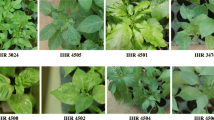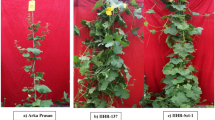Abstract
Sixty-nine tomato genotypes representing nine Solanum species were evaluated for resistance to Cucumber mosaic virus (CMV) subgroup IA and its aphid vector Myzus persicae. Resistance was assessed by visual scoring of symptoms in the field under natural conditions, and in the greenhouse by artificial inoculations through aphid M. persicae and mechanical transmissions in the year 2007 and 2009. Considerable variation in responses was observed among the evaluation methods used. Field evaluations were found liable to errors as different levels were observed for the same genotypes in the different years, however mechanical inoculation was found to be the most useful in identifying CMV subgroup IA resistance, in contrast aphid transmission was most useful in identifying insect transmission resistance. All genotypes observed as highly resistant to CMV subgroup IA in the field or through vector transmission became systemically infected through mechanical inoculations. Using mechanical inoculation, six genotypes (TMS-1 of S. lycopersicum, LA1963 and L06049 of S. chilense, LA1353, L06145 and L06223 of S. habrochaites) were found resistant and another six (L06188 and L06238 of S. neorickii, L06219 of S. habrochaites, L05763, L05776 and L06240 of S. pennellii) were found tolerant showing mild symptoms with severity index (SI) ranging 1-2 and with delayed disease development after a latent period (LP) of 18–30 days. However, these genotypes were found to be resistant to highly resistant in the field and through inoculation by M. persicae; and they also supported low population levels of M. persicae except TMS-1. Another nine genotypes (LA2184 of S. pimpinellifolium L., LA2727 of S. neorickii, LA0111, L06221, L06127 and L06231 of S. peruvianum L., LA1306, L06057 and L06208 of S. chmielewskii) showing a susceptible response after mechanical inoculation were highly resistant, resistant and tolerant after M. persicae transmission. The resistant genotypes, identified in the present study can be exploited in the breeding programmes aimed at developing tomato varieties resistant to CMV subgroup IA and broadening the genetic base of CMV-resistant germplasm. The differences observed between mechanical and aphid transmission suggests that one should consider both evaluation methods for tomato germplasm screening against CMV subgroup IA.


Similar content being viewed by others
References
Abad, J., Anastasio, G., Fraile, A., & Garcia-Arenal, F. (2000). A search for resistance to Cucumber mosaic virus in the genus Lycopersicon. Journal of Plant Pathology, 82, 39–48.
Akhtar, K. P., Ryu, K. H., Saleem, M. Y., Asghar, M., Jamil, F. F., Haq, M. A., et al. (2008). Occurrence of Cucumber mosaic virus subgroup IA in tomato in Pakistan. Journal of Plant Disease and Protection, 115, 2–3.
Akhtar, K. P., Haidar, S., Khan, M. K. R., Ahmad, M., Sarwar, N., Murtaza, M. A., et al. (2009). Evaluation of Gossypium species for resistance to Cotton leaf curl Burewala virus (CLCuBV). Annals of Applied Biology, 157, 135–147.
Ali, A., & Hassan, S. (2002). Viruses infecting winter tomato crops in the North West Frontier Province of Pakistan. Australian Journal of Agricultural Research, 53, 333–338.
Aramburu, J., Galipienso, L., & Lopez, C. (2007). Reappearance of Cucumber mosaic virus isolates belonging to subgroup IB in tomato plants in North-eastern Spain. Journal of Phytopathology, 155, 513–518.
Boissot, N., Urbino, C., Dintinger, J., & Pavis, C. (2008). Vector and graft inoculations of Potato yellow mosaic virus reveal recessive resistance in Solanum pimpinellifolium. Annals of Applied Biology, 152, 263–269.
Carrere, I., Tepfer, M., & Jacquemond, M. (1999). Recombinants of Cucumber mosaic virus (CMV): determinants of host range and symptomatology. Archives of Virology, 144, 365–379.
Choi, S. K., Choi, J. K., Park, W. M., & Ryu, K. H. (1999). RT-PCR detection and identification of three species of cucumoviruses with a genus-specific single pair of primers. Journal of Virological Methods, 83, 67–73.
Cillo, F., Pasciuto, M. M., De Giovanni, C., Finetti-Sialer, M. M., Ricciardi, L., & Gallitelli, D. (2007). Response of tomato and its wild relatives in the genus Solanum to Cucumber mosaic virus and satellite RNA combinations. Journal of General Virology, 88, 3166–3176.
Clark, M. F., & Adams, A. N. (1977). Characteristics of the microplate method of enzyme-linked immunosorbent assay for detection of plant viruses. Journal of General Virology, 34, 475–483.
Crescenzi, A., Barbarossa, L., Gallitelli, D., & Martelli, G. P. (1993). Cucumber mosaic cucumovirus population in Italy under natural epidemic conditions after a satellite-mediated protection test. Plant Disease, 77, 28–33.
Delatte, H., Holota, H., Reynaud, B., & Dintinger, J. (2006). Characterization of a quantitative resistance to vector transmission of Tomato yellow leaf curl virus in Lycopersicon pimpinellifolium. European Journal of Plant Pathology, 114, 245–253.
Ding, S. W., Anderson, B. J., Haase, H. R., & Symons, R. H. (1994). New overlapping gene encoded by the Cucumber mosaic virus genome. Virology, 198, 593–601.
Edwardson, J. R., & Christie, R. G. (1991). Cucumoviruses. In CRC handbook of viruses infecting legumes (pp. 293–319). Boca Raton: CRC.
Farrer, R. R., & Kennedy, G. G. (1991). Insect and mite resistance in tomato. In G. Kalloo (Ed.), Genetic improvement of tomato (pp. 121–142). New York: Springer-Verlag.
Gal-On, A., Wolf, D., Wang, Y. Z., Faure, J. E., & Pilowsky, M. A. (1998). Transgenic resistance to Cucumber mosaic virus in tomato: blocking of long-distance movement of the virus in lines harboring a defective viral replicase gene. Phytopathology, 88, 1101–1107.
García-Arenal, F., & Palukaitis, P. (2008). Cucumber mosaic virus. Encyclopedia of Virology (Third Edition) (pp. 614–619)
Gebre, S. K., Laterrot, H., Marshoux, G., Ragozzino, G., & Saccardo, A. (1990). Resistance to Potato virus Y and Cucumber mosaic virus in Lycopersicon hirsutum. Report of the Tomato Genetics Cooperative, 40, 12–13.
Hayes, R. J., & Buck, K. W. (1990). Infectious Cucumber mosaic virus RNA transcribed in vitro from clones obtained from cDNA amplified using the polymerase chain reaction. Journal of General Virology, 71, 2503–2508.
Hellwald, K.-H., Zimmermann, C., & Buchenauer, H. (2000). RNA 2 of Cucumber mosaic virus subgroup I strain NT-CMV is involved in the induction of severe symptoms of tomato. European Journal of Plant Pathology, 106, 95–99.
Hoogstraten, L. (1992). New TYLCV tolerant tomato varieties from Royal Sluis. Tomato Leaf Curl Newsletter, 2, 1.
Jones, J. B., Jones, J. P., Stall, R. E., & Zitter, T. A. (1997). Compendium of tomato diseases. The American Phytopathological Society. 3340. Pilot Knob Road, Minnesota, 55121-2097, USA (p 73).
Jorda, C., Afar, A., Aranda, M. A., Moriones, E., & Garcia-Arenal, F. (1992). An epidemic of Cucumber mosaic virus plus satellite RNA in tomatoes in Eastern Spain. Plant Disease, 76, 363–366.
Kaper, J. M., & Waterworth, H. E. (1981). Cucumoviruses. In E. Kurstak (Ed.), Handbook of plant virus infections and comparative diagnosis (pp. 257–232). Amsterdam: Elsevier/North Holland Biomedical Press.
Kaplan, I. B., Shintaku, M. H., Li, Q., Zhang, L., Marsh, L. E., & Palukaitis, P. (1995). Complementation of virus movement in transgenic tobacco expressing the Cucumber mosaic virus 3a gene. Virology, 209, 188–199.
Kohler, G. R., & St. Clair, D. A. (2005). Variation for resistance to Aphids (Homoptera: Aphididae) among tomato inbred backcross lines derived from wild Lycopersicon species. Journal of Economic Entomology, 98, 988–995.
Kumar, N. K. K., & Ullman, D. E. (1993). Evaluation of Lycopersicon germplasm for Tomato spotted wilt tospovirus resistance by mechanical and thrips transmission. Plant disease, 77, 938–941.
Martin, B., & Fereres, A. (2003). Evaluation of a choice-test method to assess resistance of melon to Aphis gossypii Glover (Homoptera: Aphididae) by comparison with conventional antibiosis and antixenosis trials. Applied Entomology and Zoology, 38, 405–411.
Nitzany, F. E. (1992). Cucumber mosaic virus in Isreal. Phytopathology Mediterranean, 14, 16–20.
Palukaitis, P., Roosinck, M. J., Dietzgen, R. G., & Francki, R. I. B. (1992). Cucumber mosaic virus. Advances in Virus Research, 41, 281–348.
Parella, G., Laterrot, H., Legnani, R., Gebre, S. K., Marchoux, G., Ercolano, M., et al. (1997). Factors affecting the expression of the resistance to CMV in two accessions of L. hirsutum: role of the temperature and plant age. In Proceeding of Eucarpia XIII, Jerusalem, Israel, (p 48).
Phills, B. R., Provvidenti, R., & Robinson, R. W. (1977). Reaction of Solanum Lycopersicoides to viral disease of the tomato. Report of the Tomato Genetics Cooperative, 27, 18.
Pico, B., Diez, M. J., & Nuez, F. (1998). Evaluation of whitefly-mediated inoculation techniques to screen Lycopersicon esculentum and wild relatives for resistance to tomato yellow leaf curl virus. Euphytica, 101, 259–271.
Pioven, N. M., Uzeategui, R. C. D., & Infante, D. H. (1995). Resistance to Tomato yellow mosaic virus in species of Lycopersicon. Plant Disease, 79, 590–594.
Pratap, D., Kumar, S., & Raj, K. (2008). First molecular identification of a Cucumber mosaic virus isolate causing shoestring symptoms on tomato in India. Australasian Plant Disease Notes, 3, 57–58.
Rahman, M., Hussain, D., Malik, T. A., & Zafar, Y. (2005). Genetics of resistance to cotton leaf curl disease in Gossypium hirsutum. Plant Pathology, 54, 764–772.
Roossinck, M. J. (2002). Evolutionary history of Cucumber mosaic virus deduced by phylogenetic analysis. Journal of Virology, 76, 3382–3387.
Ryu, K. H., & Park, W. M. (1995). Rapid detection and identification of Odontoglossum ringspot virus by polymerase chain reaction amplification. FEMS Microbiology Letters, 133, 265–269.
Stamova, L. (1993). Scope of the breeding tomatoes for disease resistance in Bulgaria. Proceeding of XII Eucarpia Sypmosium, Plovdiv 11–19.
Stamova, B. S., & Chetelat, R. T. (2000). Inheritance of genetic mapping of Cucumber mosaic virus resistance introgressed from Lycopersicon chilense into tomato. Theoretical and Applied Genetics, 101, 527–537.
Stamova, L., Christova, D., & Yordanov, M. (1990). Resistance to Cucumber mosaic virus (CMV). Report of the Tomato Genetics Cooperative, 40, 33–34.
Stoimenova, E., Sotirova, V., & Valkova, Z. (1992). Sources of resistance to the Cucumber mosaic virus in the genus Lycopersicon. CR Academy of Science Bulgaria, 8, 107–109.
Sudhakar, N., Nagendra-Prasad, D., Mohan, N., & Murugesan, K. (2006). First report of Cucumber mosaic virus subgroup II infecting Lycopersicon esculentum in India. Plant Disease, 90, 1457.
Sulistyowati, E., Motter, N., Bastiaan-Net, S., Roosinck, M. J., & Dietzgen, G. (2004). Host range, symptom expression and RNA 3 sequence analysis of six Australian strain of Cucumber mosaic virus. Australasian Plant Pathology, 33, 505–512.
Suzuki, M., Kuwata, S., Kataoka, J., Masuta, C., Nitta, N., & Takanami, Y. (1991). Functional analysis of deletion mutants of Cucumber mosaic virus RNA 3 using an in vitro transcription system. Virology, 183, 106–113.
Takahashi, H. (2008). Study on interaction between Cucumber mosaic virus and host plants at a molecular level. Journal of General Plant Pathology, 74, 454–456.
Taliansky, M. E., & Garcia-Arenal, F. (1995). Role of cucumovirus capsid protein in long-distance movement with the infected plant. Journal of Virology, 69, 916–922.
Tomlinson, J. A. (1987). Epidemiology and control of virus disease of vegetables. Annals of Applied Biology, 110, 661–681.
Tripathi, S., & Varma, A. (2002). Identification of sources of resistance in Lycopersicon species to Tomato leaf curl geminivirus (ToLCV) by agroinoculation. Euphytica, 129, 43–52.
Westwood, J. H., & Stevens, M. (2010). Chapter 5—resistance to aphid vectors of virus disease. natural and engineered resistance to plant viruses, part II. Advances in Virus Research, 76, 179–210.
Acknowledgements
The authors are thankful to Ayub Agricultural Research Institute, Faisalabad, Pakistan; National Agricultural Research Council, Islamabad, Pakistan; Tomato Genetic Resources Centre, USA; and Asian Vegetable Research and Development Centre, Taiwan for the provision of tomato germplasm used in this study.
Author information
Authors and Affiliations
Corresponding author
Rights and permissions
About this article
Cite this article
Akhtar, K.P., Saleem, M.Y., Asghar, M. et al. Resistance of Solanum species to Cucumber mosaic virus subgroup IA and its vector Myzus persicae . Eur J Plant Pathol 128, 435–450 (2010). https://doi.org/10.1007/s10658-010-9670-5
Accepted:
Published:
Issue Date:
DOI: https://doi.org/10.1007/s10658-010-9670-5




